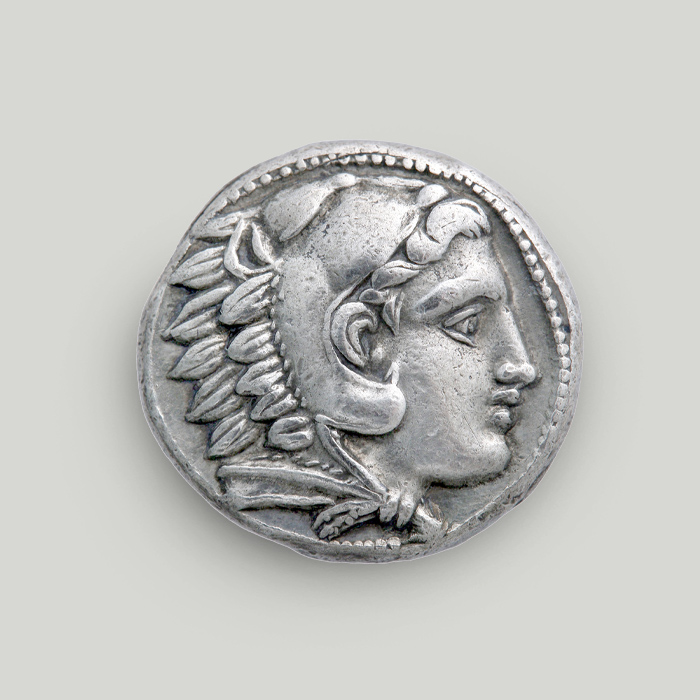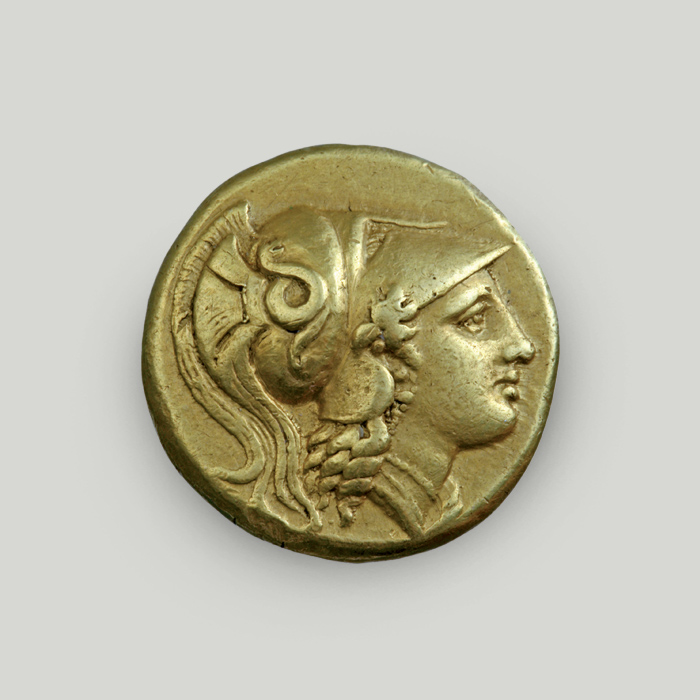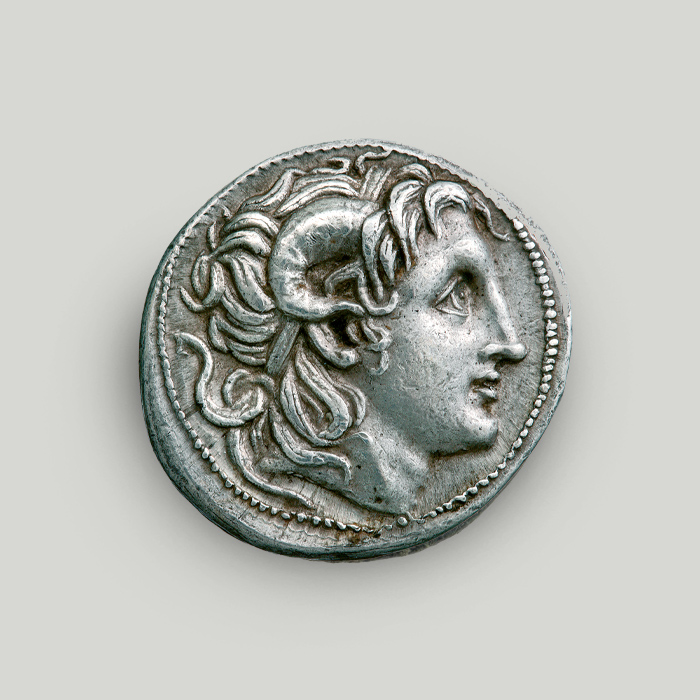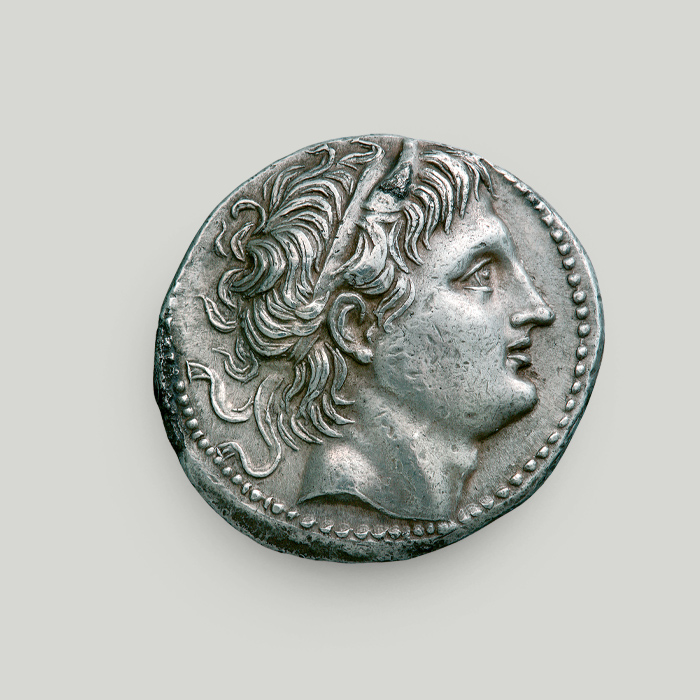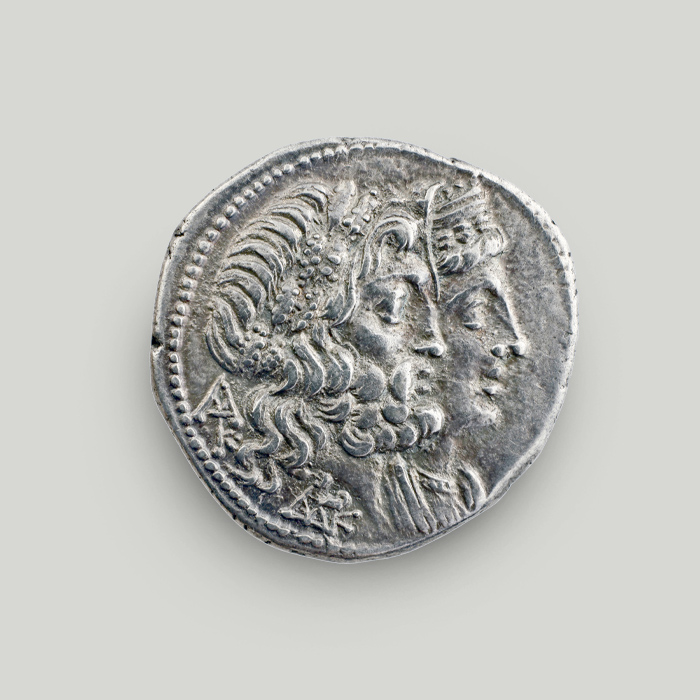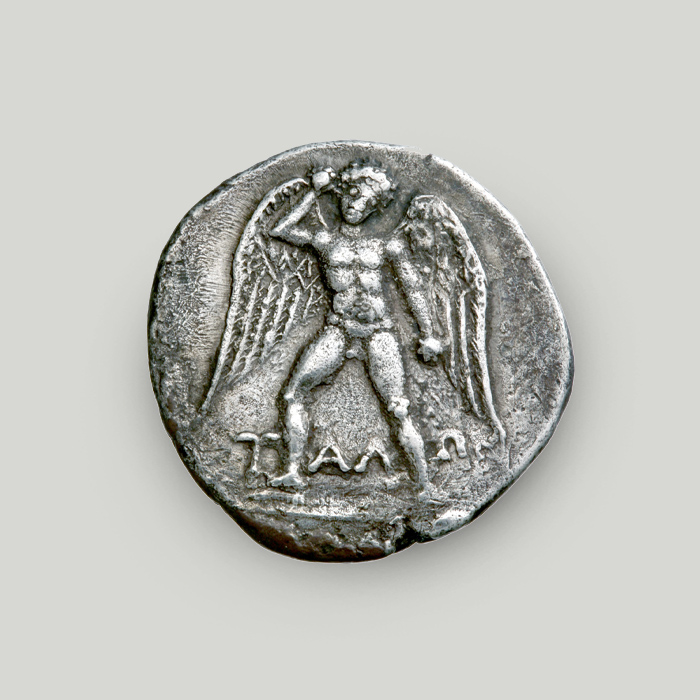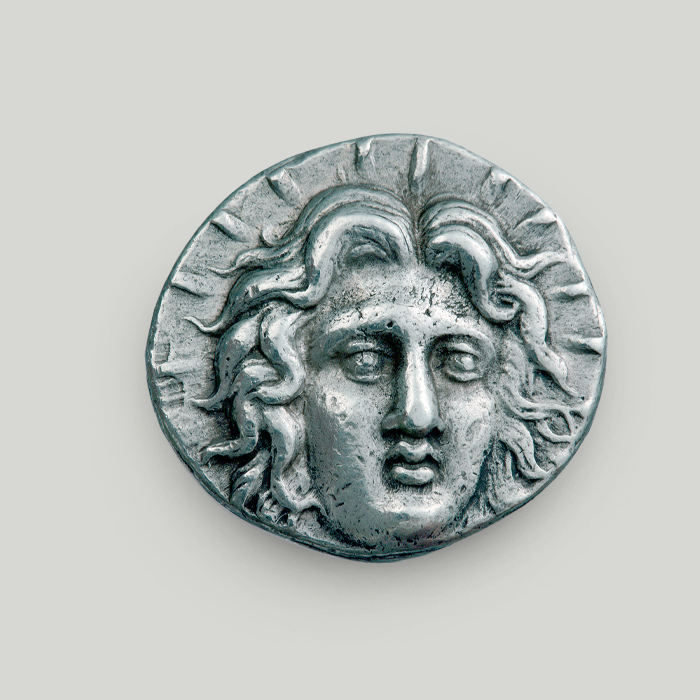Silver tetradrachm of Alexander the Great, Macedon
The silver tetradrachm of Alexander the Great was established as the standard currency in his vast empire. In today’s terms, it was the international coin of the Hellenistic period and it spawned imitations in 3 continents. The coinage struck by Alexander the Great is considered to have been the richest and most impressive in all antiquity. To fund the needs of his massive military campaigns, 26 mints in Greece and Asia Minor operated day and night.
Obverse
Head of Heracles in profile facing right. He wears a lion-skin headdress and appears within a circular dotted border.
Reverse
Enthroned Zeus. He holds an eagle in his right hand and a sceptre in his left. There is a wheat stalk under his right arm and the Greek letter Π under the throne.
The legend reads ΒΑΣΙΛΕΩΣ ΑΛΕΞΑΝΔΡΟΥ (of king Alexander).
An impressive start to Alexander’s reign
Alexander III succeeded his father, Philip II of Macedon, at the age of 20. Within a matter of a few years, he became known as Alexander the Great and earned his place in history.
Since the very beginning of his reign, he managed to establish his authority all over Macedon and the then-Greek world.
He enthusiastically agreed to lead the Hellenic League’s campaign. In spring 334 BCE, he set out from the kingdom’s capital of Pella to head east and liberate the Greek cities in Asia Minor.
A most impressive minting activity
Envisioning a more universal Greek world, Alexander introduced a drastic reform in the coinage of Macedon.
He issued and circulated a common currency, the silver tetradrachm, which conformed to the widely accepted Attic weight standard.
He applied the same standard to the gold coins he struck, such as the gold double stater, whose circulation probably started after the conquest of Tyre (332 BCE).
Coins were produced continuously in mass quantities. The systematic recruitment of mercenaries and the endless campaigns created an overwhelming need for funds. To cover all those soldiers’ wages, 26 mints in Greece and Asia Minor operated day and night.
In the end, the royal coinage struck by Alexander the Great was the richest and most impressive in all antiquity.
An international currency in antiquity
Alexander the Great managed to establish a standard currency in his vast kingdom spread across 3 continents: from the Carpathian Mountains and the Danube River to the Indus River and Egypt.
Alexander’s tetradrachms became standard in markets across the known world, replacing their Athenian counterparts. They were a strong currency and became extremely popular in antiquity.
Acquiring international status during the Hellenistic period, they soon conquered the markets of the Eastern Mediterranean.
Generations of Alexander’s successors known as the Diadochi and the Epigoni, along with many Greek cities, continued to issue the same tetradrachms long after his death.
Based on findings in hoards (i.e., collections of ancient coins recovered by archaeologists), silver tetradrachms were no longer issued after 150 BCE. The only exception was the area around the Black Sea, where they continued to be issued until 60 BCE.
The type of Alexander’s tetradrachms
The type on Alexander’s silver tetradrachms was very consistent.
The obverse depicted Heracles (the Greek equivalent of the Roman Hercules). A mythical ancestor of the Argead dynasty of Macedon, the Greek hero was also a role model for Alexander. Alexander identified himself with Heracles – a choice that took on special significance during his military campaigns.
The reverse always depicted an enthroned Zeus: he was the father of gods and men, and a protector to the Kingdom of Macedon.
Only the symbol or monogram engraved on the reverse changed. This was usually an identifying mark signifying the mint or moneyer.
Imitations of Alexander’s coinage
Individual rulers in the Haemus (now Balkan) Peninsula and some Celtic populations in the wider Danube area (3rd century BCE) issued imitations of Alexander’s coins.
The inhabitants of the Arabian Peninsula (after 250 BCE) also issued such imitations. That area was part of an important commercial route. This is why imitations there continued to be produced well into the 1st century CE.
As time went by, less and less precious metal was used in the manufacture of the blanks. Many imitations were minted using silver alloys and, later, even bronze alloys.
Fractions and etymology
As suggested by its name, the tetradrachm equalled 4 drachmas. Each drachma equalled 6 obols.
Before the invention of coins, people used iron spits of 1-1.5 meters in length for their daily transactions.
The spits was called ovelos, and 6 of them were considered a standard handful. This handful was later dubbed “drachma”, as it could be grasped (drattomai in Ancient Greek) in a person’s fist.
When coins started to circulate, the word ovelos (the previously used spits) changed to ovolos (“obol” in modern numismatics) and was used to denote the value once held by 1 spits, i.e. 1/6 of a drachma.
The coin in our publications
The silver tetradrachm of Alexander the Great is mentioned in the book Alexander the Great. From Macedonia to the Edge of the World, edited by Dr Dimitra Tsangari. The publication presents the history of Alexander the Great through his coinage and its effect on the ancient world even after his death. It includes photographs of 218 coins and detailed explanatory texts.
Buy the publication Alexander the Great. From Macedonia to the Edge of the World on the Alpha Bank e-shop.
The Alpha Bank Numismatic Collection is not open to the public.
Research visits to the Numismatic Collection can be organised upon request.
Contact us to book your visit.
